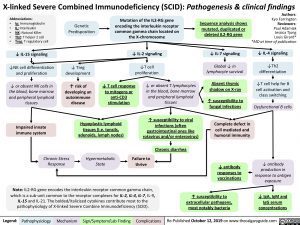

It is possible to perform X-chromosome inactivation studies to determine whether the SCID is X-linked.Īutosomal recessive SCID is caused by mutations of a series of genes (e.g., Janus kinase-3 (JAK-3), adenosine deaminase (ADA), IL-7 receptor alpha chain, CD3 delta or epsilon chain, recombination-activating gene 1 or 2 (RAG1/RAG2), Artemis, CD45). The most common form of SCID is X-linked SCID, which is caused by a mutation of the IL-2 receptor gamma. DNA sequencing can be done on fetal DNA if the family mutation is known. These tests are now commercially available. SCID is caused by several different genetic defects, and the detection of these mutations by DNA sequencing is the best way to confirm the diagnosis. What Lab Results Are Absolutely Confirmatory? Maternal IgG crosses the placenta into the baby’s circulation, so IgG levels in the newborn and young infant can be almost normal, which can affect the evaluation of response to protein vaccines. Immunoglobulin deficiency might not be recognized until several months after birth. Are There Any Factors That Might Affect the Lab Results? In particular, does your patient take any medications – OTC drugs or Herbals – that might affect the lab results? Patients with SCID essentially have no antibody formation and have very poor proliferation of lymphocytes.

This evaluation s accomplished by assessment of antibodies to standard protein vaccines (e.g., diphtheria and tetanus), isohemagglutinins (IgM against blood group antigens), and mitogen stimulation of lymphocytes. All immunoglobulin classes are usually, but not always, decreased.Įvaluation of lumphocyte function is key for the diagnosis of the disease. Total serum immunoglobulin levels of IgG, IgA, IgM, and IgE should be obtained. On average, SCID patients have fewer than 1500 lymphocytes/mL.
#Severe combined immunodeficiency scid full#
Full diagnostic assessment should be performed on any infant with severe infection or opportunistic infection. Lymphopenia with an absolute lymphocyte count less than 2500 cells/mL in an infant definitely requires further testing. In all SCID patients, T-cells are severely affected, whereas the involvement of B- and NK-cells varies based on the particular genetic mutation. Work-up of SCID should start with a complete blood cell (CBC) count with differential to determine absolute lymphocyte count, and assess lymphoid subpopulations/markers (i.e., percentages and absolute counts of CD3+ T cells, CD4+ T cells, CD8+ T cells, CD19+ B cells, and natural killer (NK) cell markers (CD16 and CD56)). The diagnostic test can be performed on venous and cord blood (at birth). To confirm the clinical diagnosis of SCID, it is necessary to assess the patient’s immune function. What Tests Should I Request to Confirm My Clinical Dx? In addition, what follow-up tests might be useful?

A family history of early infant death (within 2 years of life) that is due to these symptoms should prompt consideration of SCID.


 0 kommentar(er)
0 kommentar(er)
